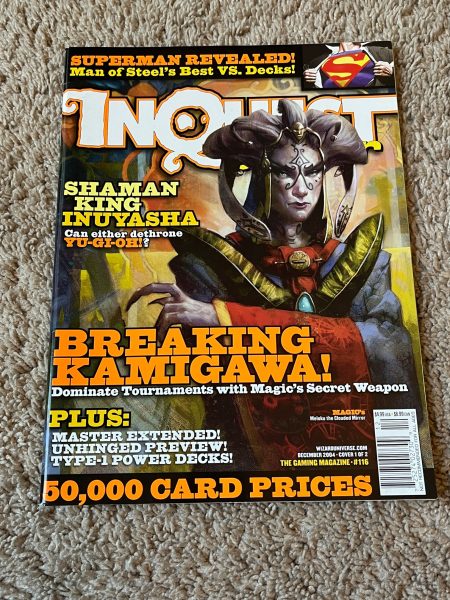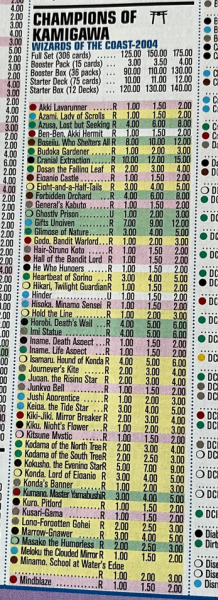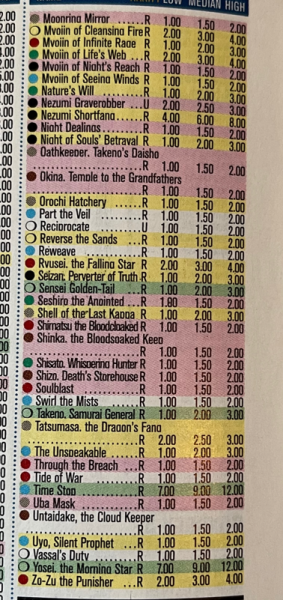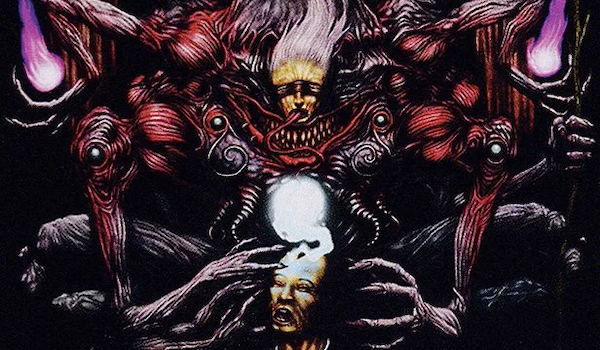Are you a Quiet Speculation member?
If not, now is a perfect time to join up! Our powerful tools, breaking-news analysis, and exclusive Discord channel will make sure you stay up to date and ahead of the curve.
Kamigawa: Neon Dyansty is upon us! Players are activating ninjutsu, checking for modified creatures, and flipping enchantments into creatures left and right. Thus far, it appears the set is going to be another success for Wizards of the Coast.
True to my New Years’ Resolution, I have once again picked up drafting on Arena with the release of this new set. I’ve got a half dozen drafts under my belt thus far, and while my beginning was a bit on the rocky side, I’ve slowly developed some confidence in my picks and deck building. My biggest success has come when including red in my draft deck, as my two trophies so far were a B/R deck and a W/R deck.
Or maybe I just win trophies when I can draft Atsushi, the Blazing Sky because this mythic has shown up in both decks.
This dragon, however, isn’t the most valuable card in the set (ignoring alternate arts, foils, etc.). It’s not a planeswalker, nor is it any mythic rare for that matter. What is the most valuable card so far, and how does it compare to the most valuable card from the original Champions of Kamigawa? Read on to find out!
Champions of Kamigawa: A Brief History Lesson
The original Champions of Kamigawa was released back in September 2004. Times were quite different in the world of MTG back then—there was no Arena, there were no mythic rares, and there definitely weren’t planeswalkers.
I thought this would be a fun chance to dust off my InQuest magazine collection to research what Champions of Kamigawa prices were like when the set first released. Technically this information would have been in the October 2004 issue. But I glanced at those prices and it looks like they were fairly inaccurate, having not reflected more than a couple weeks being on the market. Remember, the market evolved a lot more slowly back then, in a time when winning decklists were readily available prior to the set’s paper printing!
So I turned to the December 2004 issue, number 116, for a more accurate reflection of Champions of Kamigawa prices shortly after release. It helps that this issue boasts 50,000 card prices and how to dominate tournaments with Magic’s “Secret Weapon.”

Without looking, I tried to recall nearly 18 years ago to when the set was relatively new. I brainstormed the cards I remember from the set that dominated tournament tables in an attempt to guess the most valuable. From memory, these would be Cranial Extraction, Gifts Ungiven, and Boseiju, Who Shelters All. How did I do? Let’s take a look inside!


The most valuable card from the set as of December 2004 was indeed Cranial Extraction!
I remembered this one distinctly as being the card to open for maximum value. I didn’t play competitive Magic back in 2004, and I never once cast this card in a game of Magic. Nowadays, I don’t even think it’s particularly strong. But back then, the ability to completely annihilate an opponent’s key combo piece or win condition must have been pretty powerful. InQuest prices the card at $10-$15 but I distinctly remember it peaking in the $20 range back in the day.
Next is a four-way tie, with each card worth $8-$12 (thereby rounding out the top 5):
Boseiju, Who Shelters All (nailed it!)
Gifts Ungiven (nailed this one, too!)
Time Stop (I completely forgot about this one!)
Yosei, the Morning Star (OK, I didn’t think of this cycle of creatures, but I guess they were powerful)
That’s five rares worth roughly $10-$15 from the set, not to mention an array of cards in the $5 range (meaning it would have been worth opening one of these in your booster pack, financially speaking). Over time I’m sure these values evolved as well. I know Isamaru, Hound of Konda made waves in competitive Magic. Kokusho, the Evening Star was also very powerful. And who could forget the original printing of Kiki-Jiki, Mirror Breaker?
In summary, the most valuable card in the set was a powerful, black sorcery that exiled an opponent’s most important deck piece. Following that was a land that enabled your spells to be uncounterable, a timeless card tutoring engine, a novel (at the time) ability to abruptly end a turn, and a sweet, legendary creature. Not bad for top five.
Back to the Future with Kamigawa: Neon Dynasty
Let’s fast forward back to today, where players are getting their hands on Kamigawa: Neon Dynasty cards for the first time. I fully expect prices to evolve more over the next month, but as I mentioned before, with the advent of Arena and widespread adoption of TCGplayer, prices tend to stabilize much more quickly when a new set is released. We can see which cards are dominant via Arena before the paper cards are even available in stores!
So what are the top five most valuable (non-foil, non-promo, non-alternate art) cards from Magic’s newest set?
According to Card Kingdom, the leader is a rare land, which coincidentally also contains the name “Boseiju!” It looks like Boseiju has gone from “sheltering all” to “enduring” in a very productive way, because the most valuable card in the set is currently Boseiju, Who Endures.
Rather than making spells uncounterable, Boseiju has taken on a more aggressive stance, granting the ability to channel it to destroy an artifact, enchantment, or nonbasic land. While the land itself is legendary, I can definitely see the merits of loading up on a few of these in your tournament deck—its versatility is unbound, and in today’s competitive play, it’s virtually guaranteed you’ll have multiple targets to destroy. This card is basically like the double-faced cards from Zendikar Rising, except there’s no life to pay to have this land come into play untapped.
Currently its retail price is $30—at rare, I’m not sure it will hold this value for the duration of its time in Standard. Once supply saturates the market, it should be closer to $20.
The next four most valuable cards are all mythic rares from the set:
Jin-Gitaxias, Progress Tyrant - $21.99 (you pay for the mouthful)
The Wandering Emperor - $15.99 (The Wanderer’s face, at last)
Kaito Shizuki - $10.99 (I opened this in pack two of a draft and passed it because I had drafted 0 blue or black cards… oops?)
Kodama of the West Tree - $7.99 (finally completing the Kodama Tree cycle)
It's interesting to see how dramatically the prices fall for the most valuable cards in the set. There's a lone $30 rare, a $20-ish creature, two planeswalkers in the $10-$15 range, and then number five is already down to $8. It shakes out such that if you open a rare from your booster pack and it’s not Boseiju, you have a pretty low chance of breaking even on the booster. You could pull Otawara, Soaring City and get your money back—it currently retails for around $7. Eiganjo, Seat of the Empire ($5.99) or Farewell ($5) could also work.
Basically, if you open a rare from Kamigawa: Neon Dynasty, you are hoping it’s a land, Farewell, or Mirror Box.
It’s interesting to see how much of the set’s value is concentrated in the top couple cards. It felt like values were distributed a little more evenly back in Champions of Kamigawa, at least around the set’s initial release. I suspect this is driven by the advent of the mythic rare, the foil, the alternate art, the etched, and all the other alternate printings Wizards of the Coast has created. No longer do you want to simply open a specific rare. Now you’re effectively purchasing a scratch-off ticket where you lose most often, but have a chance of winning big with a special pull.
Kind of sounds like Pokémon, doesn’t it?
The More Kamigawa Changes...
I had fun comparing and contrasting the most valuable cards of Champions of Kamigawa circa December 2004 with the most valuable cards of Kamigawa: Neon Dynasty of today. I hope you enjoyed the trip back in time with me.
We uncovered a couple noteworthy trends. First, it’s funny how Boseiju’s facelift was strong enough to keep it in the top five most valuable cards of the set, just like it was back in 2004. In 2004, the other valuable cards were strong spells or iconic, lengedary creatures. Nowadays, we still have iconic, legendary creatures in the top five, but the sorceries and instants were replaced by planeswalkers, which of course didn’t exist back in 2004.
Mythic rares also didn’t exist back in 2004, and I believe that also has a hand in stacking most value of the set in the top couple of cards of Neon Dynasty, whereas it was a flatter field of rares back in the day. It reinforces my belief that Magic has gone the way of Pokémon when it comes to value and collectability. Opening a non-foil, non-etched, non-alternate art rare means you probably don’t get much value anymore. Now you need to hit the “EX”, “rainbow rare”, “GX”, etc. of Magic to really pull something valuable.
I suppose this helps make the game less expensive for those just wanting to jam together a competitive pile of sixty cards to battle at a tournament. That’s not necessarily a bad thing, however who is playing in tournaments these days? With the recent, major changes to organized play, it doesn’t seem like the tournament scene is as robust as it once was… at least, not on paper. And if you’re jamming tournaments on Arena, you don’t have to spend a dime on a single card.
In fact, that’s my favorite aspect of Arena. I don’t like spending money on new cards for reasons detailed above, but I do appreciate the occasional draft. Arena lets me enjoy a few drafts (or more) to appreciate a new set’s flavor and mechanics without sinking a dime into the hobby—and without stepping foot inside a store. Good for me, but probably not ideal for local game shops. It’ll be interesting to see how the hobby continues to evolve going forward in the world’s “new normal.” I won’t try to predict the future—only time will tell!









